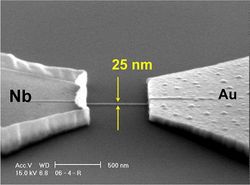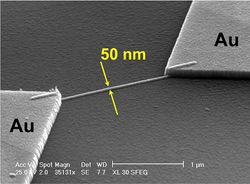Characterization of metallic nanostructures
The interest in transport phenomena in solid state nanostructures has been steadily growing over the recent years. On the one hand, this is caused by refined experimental and theoretical methods which are employed in current research on nanostructure devices. On the other hand, the rapid downscaling of integrated circuit technologies creates the need to understand the electronic transport properties in individual structures lateral dimensions below 100 nm.
A main focus of the research activities at the Walther-Meissner-Institute is the study of mesocopic metallic systems. The term mesoscopic describes systems with lateral dimensions between microscopic systems like atoms and molecules and objects with macroscopic dimensions. The physical quantity which is usually used to characterize mesoscopic dimensions is the phase coherence length, which describes the length over which electrons do not loose there phase information and keep the ability to interfere with other charge carriers. In structures which are in at least one dimension smaller in size or comparable to the phase coherence length the quantum wave nature of the charge carriers leads to a variety of macroscopically observable interference effects which can not be described by standard transport theory.
The main focus of our work in mesoscopic metallic systems is:
- The fabrication of metallic nanostructures such as metallic nanowires (Au, Ag, Al, Co) with lateral dimensions down to 20 nm.
- The investigation of quantum interference effects on electronic transport in normal metal structures and normal metal-superconductor heterostructures.
- The study of shot-noise and 1/f-Noise in metallic nanostructures.
- The study of single charge tunneling and spin effects in ferromagnet-superconductor heterostructures.

